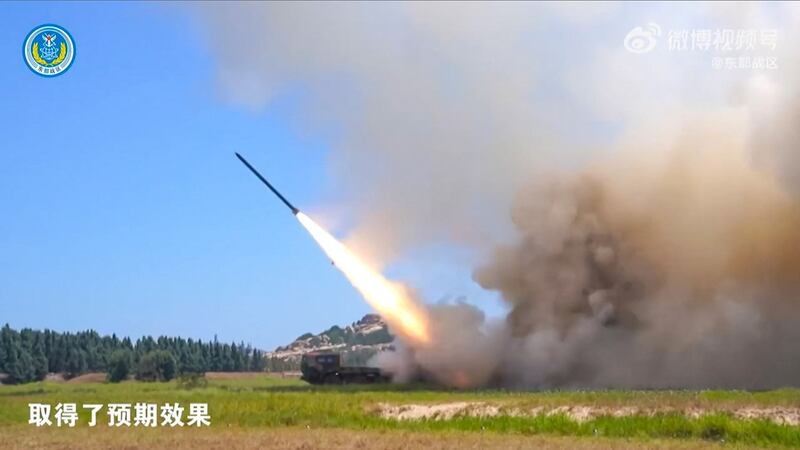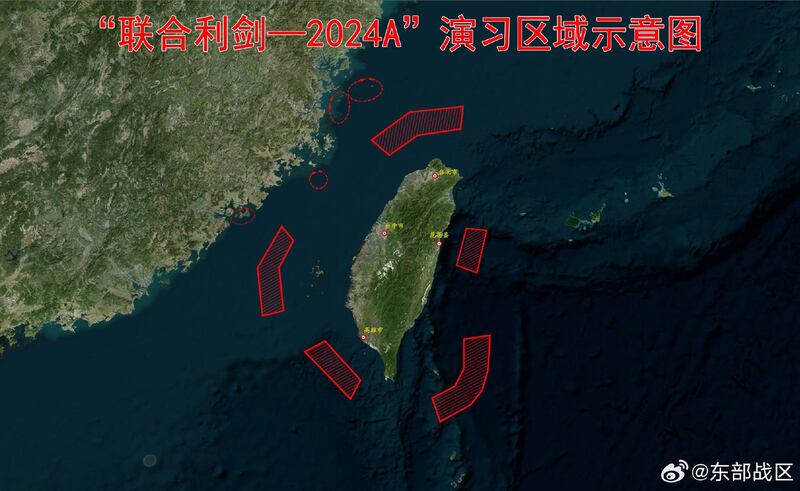Updated May 23, 2024, 04:41 a.m. ET.
The Chinese military on Thursday launched large-scale drills around Taiwan, three days after new President Lai Ching-te took office, as “punishment” for the democratic island’s “separatist acts.”
“The drills are being conducted in the Taiwan Strait, the north, south and east of Taiwan Island, as well as areas around the islands of Kinmen, Matsu, Wuqiu, and Dongyin,” China’s defense ministry said on its website.
The Joint Sword-2024A drills combine multiple branches of the armed forces under the Eastern Theater Command of the People’s Liberation Army (PLA) and will last until Friday.
A spokesperson for the command said the exercises serve as a strong punishment for the separatist acts of what he called “Taiwan independence forces” and as a stern warning against interference and provocation by external forces, a veiled reference to the United States and its allies.
The spokesperson, Li Xi, said the army, navy, air force and rocket force of the theater command had joined the exercise.

China, which considers Taiwan a breakaway province, often stages military exercises in response to major political events on the island. The scale of the exercises invariably depends on the significance of the event.
In August 2022, after then-U.S. House Speaker Nancy Pelosi visited Taipei, the PLA conducted a week of joint drills around Taiwan, including live-fire exercises, followed by anti-submarine attacks and air drills. Pelosi was the most senior U.S. official to visit Taiwan in 25 years.
“The code name of this exercise is Joint Sword 2024, which means it is a continuation of the exercise in 2022 after Nancy Pelosi’s visit,” said Shen Ming-shih, a Taiwanese military expert from the Institute for National Defense and Security Research in Taipei.
“There will be more of such exercise this year as it becomes routine but they won’t be large-scale aggressions,” Shen added.
The PLA’s Eastern Theater Command posted a map on the Weibo microblogging site showing locations of the drills, which appears similar to the August 2022 exercises but with the addition of areas near Taiwan’s outer islands.
A witness in the Kinmen islands told Radio Free Asia that since Thursday morning, two formations of Chinese vessels had been spotted operating near the islands.
Outside the island chain
Spokesperson Li said Joint Sword-2024A was focused on joint sea-air combat-readiness patrols, joint seizure of comprehensive battlefield control, and joint precision strikes.
Chinese military vessels and planes would be conducting patrols and integrated operations inside and outside the island chain “to test the joint real combat capabilities of the forces of the command,” he said.
Military analyst, Ben Lewis, said that means the PLA will send aircraft further eastward.
“I think it is likely they will operate in West Pacific, based on the exercise zones and stated objectives of the drill,” Lewis told RFA.

In a press statement, Taiwan’s ministry of defense condemned the exercise and “expressed regret for such irrational provocations and actions that undermine regional peace and stability.”
The ministry said it had mobilized joint intelligence, surveillance and reconnaissance systems, as well as air defense and land-based missile forces, to monitor the situation in order to respond to emergencies.
Such PLA drills are largely anticipated and “included” in Taiwan’s defense planning, according to the ministry.
China's actions have “caused substantial damage to global peace and stability,” it said, adding that they also highlight Beijing’s “hegemonic nature.”
Lai Ching-te, who China views as a “separatist,” was sworn in as Taiwan’s president on Monday.
Lai said in his acceptance speech that his government would strive to “maintain the status quo” with China but “we must not have illusions.”
“Before China gives up using force to invade Taiwan, citizens must understand this: even if we accept all of China’s claims and give up our sovereignty, China’s ambition to annex Taiwan will not disappear.”
China’s Taiwan Affairs Office said that Lai sent “dangerous” signals that seek to undermine peace and stability.
Edited by Mike Firn and Taejun Kang.
Updated to add an expert comment.
